Attractions Nearby Machu Picchu, Day Trips and Excursions
(Machu Picchu, Peru)
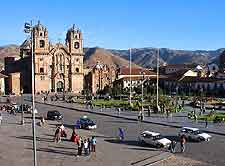
So many people visiting Peru are desperate to experience the attractions of Machu Picchu close up. However, once you have been to Machu Picchu, a number of further attractions of real quality lay all around southern
Peru, being within easy reach of travellers and backpackers.
Almost everyone visiting Machu Picchu will find themselves exploring the neighbouring town of Aguas Calientes, or a little further away, the city of
Cusco. Head south and you will soon reach Puno,
Juliaca and
Lake Titicaca, while to the west, additional attractions include those within
Ayacucho and
Huancayo, with both
Lima and
Callao being sited to the far north-west and alongside the Pacific coastline.
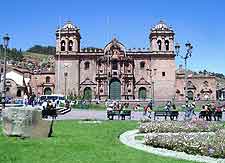
Cusco
One of the most visited of all the cities in Peru, Cusco is both a popular and expensive place to spend a holiday. Many people heading for Machu Picchu, the
Sacred Valley or the
Inca Trail choose to base themselves in Cusco, for the sheer convenience of its proximity to the Lost City of the Incas. However, Cusco also has much to offer in the way of tourist attractions and sights worth seeing, with favourite museums including the
Museo de Historia Natural, the Museo Inka, the
Museo de Arte Precolombino and also the Museo Historico Regional, amongst many others. A host of recreational attractions and
activities are also available around Cusco for the more adventurous tourists, such as white-water rafting, trekking, mountaineering, rock climbing, mountain biking and even paragliding.
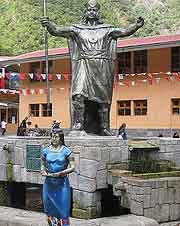
Aguas Calientes
Most people exploring Machu Picchu will at some stage likely stop or pass through Aguas Calientes. This small town is so close to the actual Inca ruins that it is often referred to as the Machu Picchu Pueblo, and really is the only location of any significance to offer accommodation, shops and places to eat. Although Aguas Calientes boasts a very scenic setting, in a deep valley and is surrounded by stone walls, in reality this is a very commercial town with unplanned developments, targeting tourists at every opportunity. Staying at Aguas Calientes for one night comes very highly recommended, since those sleeping here are able to catch an early morning bus and will be amongst the first to arrive at Machu Picchu, before the crowds turn up. If you can, do try to stick around until late afternoon, when the crowds seem to magically disappear.
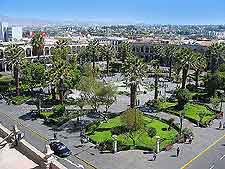
Arequipa
Head directly south of Machu Picchu and you will eventually encounter the city of
Arequipa, although it is really a little too far to make a day trip worthwhile. With many of the most obvious
sights residing in the centre of Arequipa, around the
Plaza de Armas, sightseeing in the city is fairly straightforward. Look out for Arequipa's
Museo Santury, Monasterio de Santa Catalina, Iglesia de la Compania church,
Museo de Arte Virreinal de Santa Teresa, and plentiful colonial mansions, which add a very stately presence to various parts of the city.
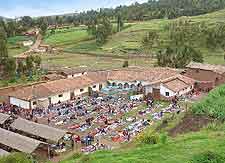
Chinchero
Chinchero was always thought by the Incas to be the birthplace of rainbows and therefore, for that reason, holds a very important place in Inca history. With Inca ruins, archaeological attractions and a very attractive colonial church, Chinchero also boasts some very extraordinary mountain views and a rather lively Sunday market. However, at around 400 metres / 1,310 feet higher than Cusco, do take time to properly acclimatise to this high altitude, so that you can fully enjoy spending time here.
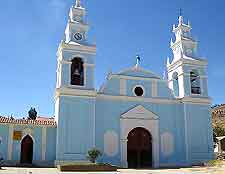
Huancayo
The city of
Huancayo is a sizable place, with a population close to 400,000 people and plenty to see in the way of
tourist attractions. Sitting to the north-west of Machu Picchu, those travelling here by bus will usually arrive at the Plaza de la Constiticion, close to the cathedral. Visitors to Huancayo should be sure to check out the ceramics and historic Peruvian treasures at the
Museo Salesiano.
Juliaca
Juliaca is a large and busy city, being home to a population of around 200,000 people and an important commercial airport, the Inca Manco Cápac International Airport. Lying on the north-westerly side of
Lake Titicaca and relatively close to the lakefront, Juliaca's main attractions include its Plaza Bolognesi,
Plaza Melgar, Iglesia La Merced, Iglesia Santa Catalina and some characterful neighbouring villages.
Puno
The small port city of Puno is well placed for those heading to Lake Titicaca, since it lies on the westerly shore of the lake, south of Machu Picchu and Cusco. Puno offers a series of boat trips around Lake Titicaca, where you can appreciate some wonderful views and visit the main islands, such as the Isla Taquile and the Isla Amantani. If you have time, there are also innumerable archaeological sites surrounding much of Puno, which are also of interest, as is the historical Yavari boat, now operating as a museum and moored next to the Sonesta Posada Hotel del Inca.
Ollantaytambo
Situated to the south-east of Machu Picchu and famous for its breathtaking Inca fortress, Ollantaytambo is a small and quaint village, worthy of attention. The Ollantaytambo ruins are surrounded by a series of steep terraces and mark the actual site where Spanish conquistadors once lost a very important battle. From Ollantaytambo, you can take a walk along a 6-km / 4-mile trail, where you will find an ancient Inca quarry. The Museo CATCCO contains information about the town's past and traditional Andean celebrations.
Piquillacta (Pikillacta) / Rumicolco
Piquillacta serves as one of the region's most noteworthy pre-Inca ruins and is known to date back more than 900 years. This important ceremonial centre boasts crumbling stonework and the remains of two-story structures, suggesting its former splendour in the days of the Wari culture. Piquillacta is located to the south-east of Machu Picchu, around 40 km / 25 miles east of Cusco, and is encircled by an imposing, historical defensive wall.
Open hours: daily - 07:00 to 18:00
Admission: charge
 So many people visiting Peru are desperate to experience the attractions of Machu Picchu close up. However, once you have been to Machu Picchu, a number of further attractions of real quality lay all around southern Peru, being within easy reach of travellers and backpackers.
So many people visiting Peru are desperate to experience the attractions of Machu Picchu close up. However, once you have been to Machu Picchu, a number of further attractions of real quality lay all around southern Peru, being within easy reach of travellers and backpackers.



